Particle Swarm Optimization Algorithm-Based Design Method for Ultrasonic Transducers
Abstract
1. Introduction
2. Optimization Design Method for Ultrasonic Transducer
2.1. Equivalent Circuit Model
2.2. Optimality Criteria of Ultrasonic Transducer
2.3. Design Parameter Optimization Method under the Framework of PSO Algorithm
3. Application and Verification of the Developed Optimization Design Method
3.1. Optimization Design of Ultrasonic Transducer
3.2. Verification
3.3. Comparison and Discussion
4. Conclusions
Author Contributions
Funding
Acknowledgments
Conflicts of Interest
Symbols
| Thickness of the piezoelectric material | |
| Thickness of the matching layer | |
| Piezoceramic clamped capacity | |
| Area of the transducer | |
| Ceramic permittivity with zero or constant strain | |
| Acoustic impedance of the piezoelectric layer | |
| Density of the piezoelectric material | |
| Longitudinal velocity of the piezoelectric material | |
| Ratio of transformer | |
| Effective piezoelectric coupling coefficient | |
| Resonant frequency | |
| Reactance of piezoelectric element | |
| Input impedance of the acoustic transmission line looking towards the front acoustic port | |
| Input impedance of the acoustic transmission line looking towards the back acoustic port | |
| Wave number of the piezoelectric material | |
| Wave number of the matching layer | |
| Acoustic impedance of the matching layer | |
| Acoustic impedance of front load(acoustic impedance of water) | |
| Acoustic impedance of the backing | |
| Center frequency | |
| Bandwidth | |
| Lower frequency at which the amplitude drops to the −6 dB peak | |
| Upper frequency at which the amplitude drops to the −6 dB peak | |
| Optimality criteria of ultrasonic transducer | |
| Desired CF | |
| Desired BW | |
| Weight coefficients of CFdes | |
| Weight coefficients of BWdes | |
| Minimum values of CF | |
| Maximum values of CF | |
| Minimum values of BW | |
| Maximum values of BW | |
| The ith particle’s velocity and position | |
| The ith particle’s position | |
| Inertia weight | |
| , | Two constants |
| Best previous positions of the ith individual in current generation | |
| Best previous positions of the ith all particles in current generation | |
| , | Two random values distributed in the range of [0, 1] |
| Current iteration | |
| Maximum of the current iteration | |
| Maximum of inertia weight | |
| Minimum of inertia weight |
References
- Chen, Q.C.; Zhang, W.C.; Zhao, H. Response bandwidth design of Fabry-Perot sensors for partial discharge detection based on frequency analysis. J. Sens. 2019, 6, 1–11. [Google Scholar] [CrossRef]
- Cao, J.L.; Zou, H.S.; Yu, X.H.; Zhang, J.; Lai, H.X.; Hu, M.H.; Tu, S.D. Detection of plane sealing leakage by tuning the generated sound characteristics. Measurement 2019, 146, 815–826. [Google Scholar] [CrossRef]
- Saillant, J.F.; Marlier, R.; Navacchia, F.; Baque, F. Ultrasonic transducer for non-destructive testing of structures immersed in liquid sodium at 200 °C. Sensors 2019, 19, 4156. [Google Scholar] [CrossRef] [PubMed]
- Eaton, M.J.; Pullin, R.; Holford, K.M. Acoustic emission source location in composite materials using Delta T Mapping. Compos. Part A 2012, 43, 856–863. [Google Scholar] [CrossRef]
- Shen, M.; Wang, Y.; Jiang, Y.; Ji, H.; Wang, B.; Huang, Z. A new positioning method based on multiple ultrasonic sensors for autonomous mobile robot. Sensors 2019, 20, 17. [Google Scholar] [CrossRef] [PubMed]
- Scopelliti, M.G.; Chamanzar, M. Ultrasonically sculpted virtual relay lens for in situ microimaging. Light Sci. Appl. 2019, 8, 565–579. [Google Scholar] [CrossRef]
- Zhang, Z.; Xu, J.L.; Yang, L.L.; Liu, S.X.; Xiao, J.J.; Zhu, R.F.; Li, X.B.; Wang, X.; Luo, H.S. Fabrication of angle beam two-element ultrasonic transducers with PMN-PT single crystal and PMN-PT/epoxy 1-3 composite for NDE applications. Sens. Actuators A Phys. 2011, 168, 223–228. [Google Scholar] [CrossRef]
- Fei, C.L.; Liu, X.L.; Zhu, B.P.; Li, D.; Yang, X.F.; Yang, Y.T.; Zhou, Q.F. AlN piezoelectric thin films for energy harvesting and acoustic devices. Nano Energy 2018, 51, 146–161. [Google Scholar] [CrossRef]
- Gudra, T.; Opieliński, K.J. Influence of acoustic impedance of mutilayer acoustic systems on the transfer function of ultrasionic airborne transducers. Ultrasonics 2002, 40, 457–463. [Google Scholar] [CrossRef]
- Fei, C.L.; Ma, J.G.; Chiu, C.T.; Williams, J.A.; Fong, W.N.; Chen, Z.Y.; Zhu, B.P.; Xiong, R.; Shi, J.; Hsiai, T.K.; et al. Design of matching layers for high-frequency ultrasonic transducers. Appl. Phys. Lett. 2015, 107, 123505. [Google Scholar] [CrossRef]
- Yang, X.Y.; Fei, C.L.; Li, D.; Sun, X.H.; Hou, S.; Chen, J.; Yang, Y.T. Multi-layer polymer-metal structures for acoustic impedance matching in high-frequency broadband ultrasonic transducers design. Appl. Phys. 2020, 160, 107123. [Google Scholar]
- Krimholtz, R.; Leedom, D.A.; Matthaei, G.L. New equivalent circuits for elementary piezoelectric transducers. Electron. Lett. 1970, 6, 398–399. [Google Scholar] [CrossRef]
- Qian, Y.; Harris, N.R. Modelling of a novel high-impedance matching layer for high frequency (>30 MHz) ultrasonic transducers. Ultrasonics 2011, 54, 586–591. [Google Scholar] [CrossRef] [PubMed][Green Version]
- Lau, S.T.; Li, H.; Wong, K.S.; Zhou, Q.F.; Zhou, D.; Li, Y.C.; Luo, H.S.; Shung, K.; Dai, J.Y. Multiple matching scheme for broadband 0.72Pb(Mg1/3Nb2/3)O3-0.28PbTiO3 single crystal phased-array transducer. J. Appl. Phys. 2009, 105, 094908. [Google Scholar] [CrossRef]
- Ma, J.P.; Xue, S.D.; Zhao, X.Y.; Wang, F.F.; Tang, Y.X.; Duan, Z.H.; Wang, T.; Shi, W.Z.; Yue, Q.W.; Zhou, H.F.; et al. High frequency transducer for vessel imaging based on lead-free Mn-doped (K0.44Na0.56) NbO3 single crystal. Appl. Phys. Lett. 2017, 111, 092903. [Google Scholar] [CrossRef]
- Bawiec, C.R.; Sunny, Y.; Nguyen, A.T.; Samuels, J.A.; Weingarten, M.S.; Zubkov, L.A.; Lewin, P.A. Finite element static displacement optimization of 20–100 kHz flexural transducers for fully portable ultrasound applicator. Ultrasonics 2013, 53, 511–517. [Google Scholar] [CrossRef]
- Fei, C.L.; Yang, Y.H.; Guo, F.F.; Lin, P.F.; Chen, Q.; Zhou, Q.F.; Sun, L. PMN-PT single crystal ultrasonic transducer with half-concave geometric design for IVUS imaging. IEEE Trans. Biomed. Eng. 2018, 65, 2087–2092. [Google Scholar] [CrossRef]
- Fiorillo, A.S.; Pullano, S.A.; Bianco, M.G.; Critello, C.D. Ultrasonic transducers shaped in archimedean and fibonacci spiral: A comparison. Sensors 2020, 20, 2800. [Google Scholar] [CrossRef]
- Fiorillo, A.S.; Pullano, S.A.; Critello, C.D. spiral-shaped biologically-inspired ultrasonic sensor. IEEE Trans. Ultrason. Ferroelectr. Freq. Control 2019, 67, 635–642. [Google Scholar] [CrossRef]
- Chen, J.; Zhao, J.Y.; Lin, L.; Sun, X.Y. Truncated conical PVDF film transducer for air ultrasound. IEEE Sens. J. 2019, 19, 8618–8625. [Google Scholar] [CrossRef]
- Wang, Z.P.; Luo, Y.; Zhao, G.Q.; Yuan, F.G. Design and optimization of an OPFC ultrasonic linear phased array transducer. Int. J. Mech. Mater. Des. 2015, 13, 57–69. [Google Scholar] [CrossRef]
- Feeney, A.; Kang, L.; Rowlands, G.; Zhou, L.Q.; Dixon, S. Dynamic nonlinearity in piezoelectric flexural ultrasonic transducers. IEEE Sens. J. 2019, 19, 6056–6066. [Google Scholar] [CrossRef]
- Zhang, Z.; Xu, J.L.; Yang, L.L.; Liu, S.X.; Xiao, J.J.; Li, X.B.; Wang, X.A.; Luo, H.S. Design and comparison of PMN-PT single crystals and PZT ceramics based medical phased array ultrasonic transducer. Sens. Actuators A Phys. 2018, 283, 273–281. [Google Scholar] [CrossRef]
- Takpara, R.; Duquennoy, M.; Ouaftouh, M.; Courtois, C.; Jenot, F.; Rguiti, M. Optimization of PZT ceramic IDT sensors for health monitoring of structures. Ultrasonics 2017, 79, 96–104. [Google Scholar] [CrossRef] [PubMed]
- Wan, Z.; Chen, Y.; Huang, S.; Feng, D.D. A modified nonmonotone BFGS algorithm for solving smooth nonlinear equations. Optim. Lett. 2014, 8, 1845–1860. [Google Scholar] [CrossRef]
- Huang, S.; Wan, Z.; Deng, S.H. A modified projected conjugate gradient algorithm for unconstrained optimization problems. ANZIAM J. 2013, 54, 143–152. [Google Scholar]
- Huang, S.; Wan, Z.; Chen, X. A new nonmonotone line search technique for unconstrained optimization. Numer. Algorithms 2015, 68, 671–689. [Google Scholar] [CrossRef]
- Chen, D.D.; Lin, Y.C. A particle swarm optimization-based multi-level processing parameters optimization method for controlling microstructures of an aged superalloy during isothermal forging. Met. Mater. Int. 2019, 25, 1246–1257. [Google Scholar] [CrossRef]
- Chen, D.D.; Lin, Y.C.; Chen, X.M. A strategy to control microstructures of a Ni-based superalloy during hot forging based on particle swarm optimization algorithm. Adv. Manuf. 2019, 7, 238–247. [Google Scholar] [CrossRef]
- Zhang, J.; Zhao, Y.; Ge, Y.; Li, M.; Yang, L.; Mao, X. Design optimization and fabrication of high-sensitivity SOI pressure sensors with high signal-to-noise ratios based on silicon nanowire piezoresistors. Micromachines 2016, 7, 187. [Google Scholar] [CrossRef]
- Chen, D.D.; Hou, C.X.; Fei, C.L.; Li, D.; Lin, P.F.; Chen, J.; Yang, Y.T. An optimization design strategy of 1-3 piezocomposite ultrasonic transducer for imaging applications. Mater. Today Commun. 2020, 24, 100991. [Google Scholar] [CrossRef]
- Gu, H.; Su, W.; Zhao, B.; Zhou, H.; Liu, X. A design methodology of digital control system for MEMS gyroscope based on multi-objective parameter optimization. Micromachines 2020, 11, 75. [Google Scholar] [CrossRef] [PubMed]
- Zhou, Q.F.; Lau, S.T.; Wu, D.W.; Shung, K. Piezoelectric films for high frequency ultrasonic transducers in biomedical applications. Prog. Mater. Sci. 2011, 56, 139–174. [Google Scholar] [CrossRef] [PubMed]
- Oakley, C.G. Calculation of ultrasonic transducer signal-to-noise ratios using the KLM model. IEEE Trans. Ultrason. Ferroelectr. Freq. Control 1997, 44, 1018–1026. [Google Scholar] [CrossRef]
- Van Kervel, S.J.H.; Thijssen, J.M. A calculation scheme for the optimum design of ultrasonic transducers. Ultrasonics 1983, 21, 134–140. [Google Scholar] [CrossRef]
- Liu, H.W.; Ren, W.; Zhao, J.Y.; Zhao, H.F.; Wu, X.Q.; Shi, P.; Zhou, Q.F.; Shung, K. Design and fabrication of high frequency BNT film based linear array transducer. Ceram. Int. 2015, 41, S631–S637. [Google Scholar] [CrossRef]
- Dai, H.P.; Chen, D.D.; Zheng, Z.S. Effects of random values for particle swarm optimization algorithm. Algorithms 2018, 11, 23. [Google Scholar] [CrossRef]
- Nickabadi, A.; Ebadzadeh, M.M.; Safabakhsh, R. A novel particle swarm optimization algorithm with adaptive inertia weight. Appl. Soft. Comput. 2011, 11, 3658–3670. [Google Scholar] [CrossRef]
- Yang, X.; Li, Z.X.; Fei, C.L.; Liu, Y.B.; Li, D.; Hou, S.; Zhang, L.; Li, F.; Yang, Y.T.; Zhou, Q.F.; et al. High frequency needle ultrasonic transducers based on Mn doped piezoelectric single crystal. J. Alloys Compd. 2020, 832, 154951. [Google Scholar] [CrossRef]
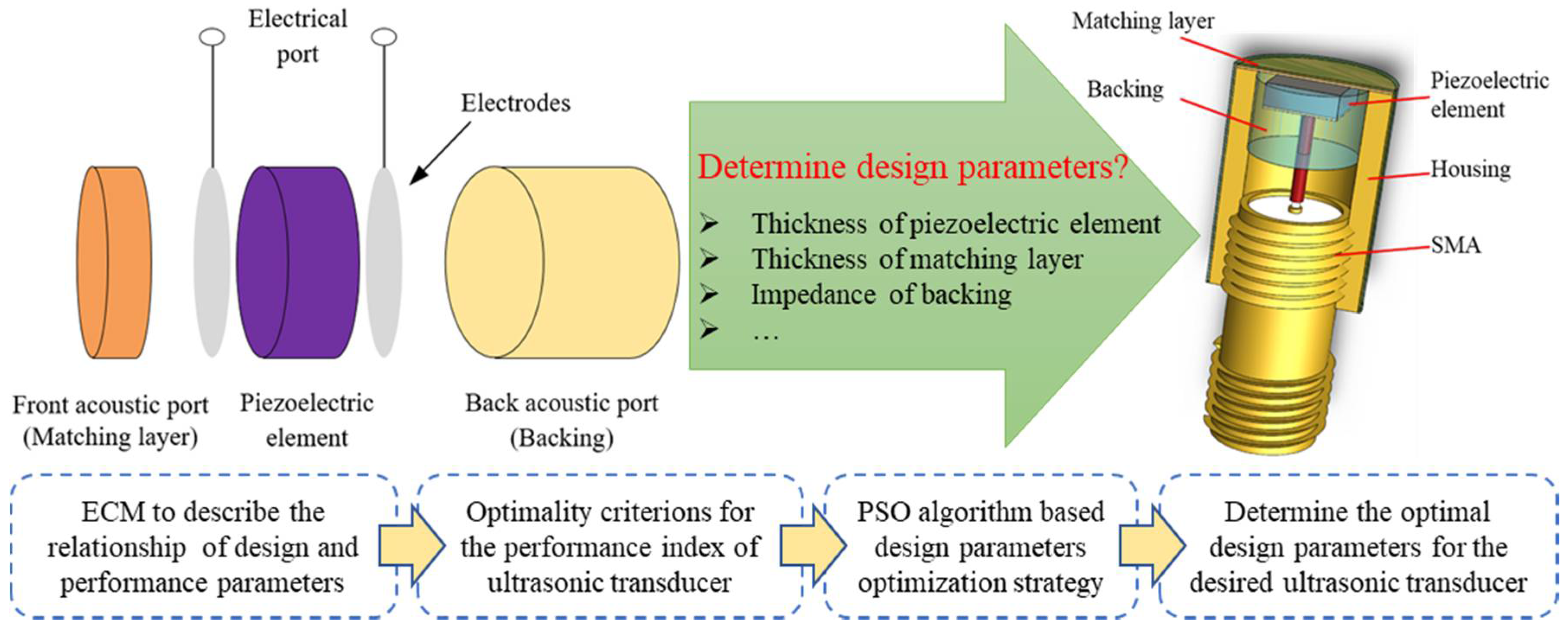
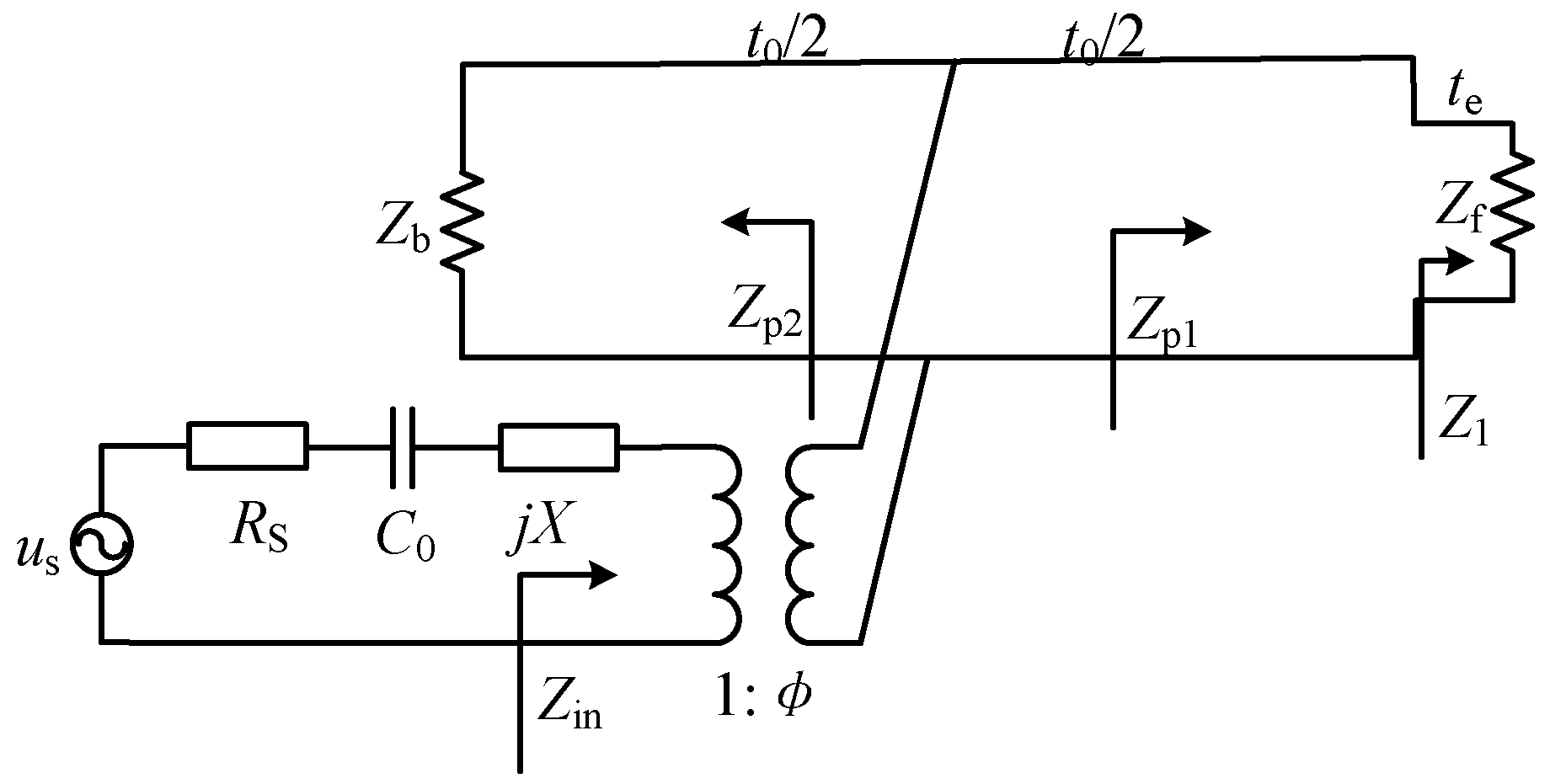


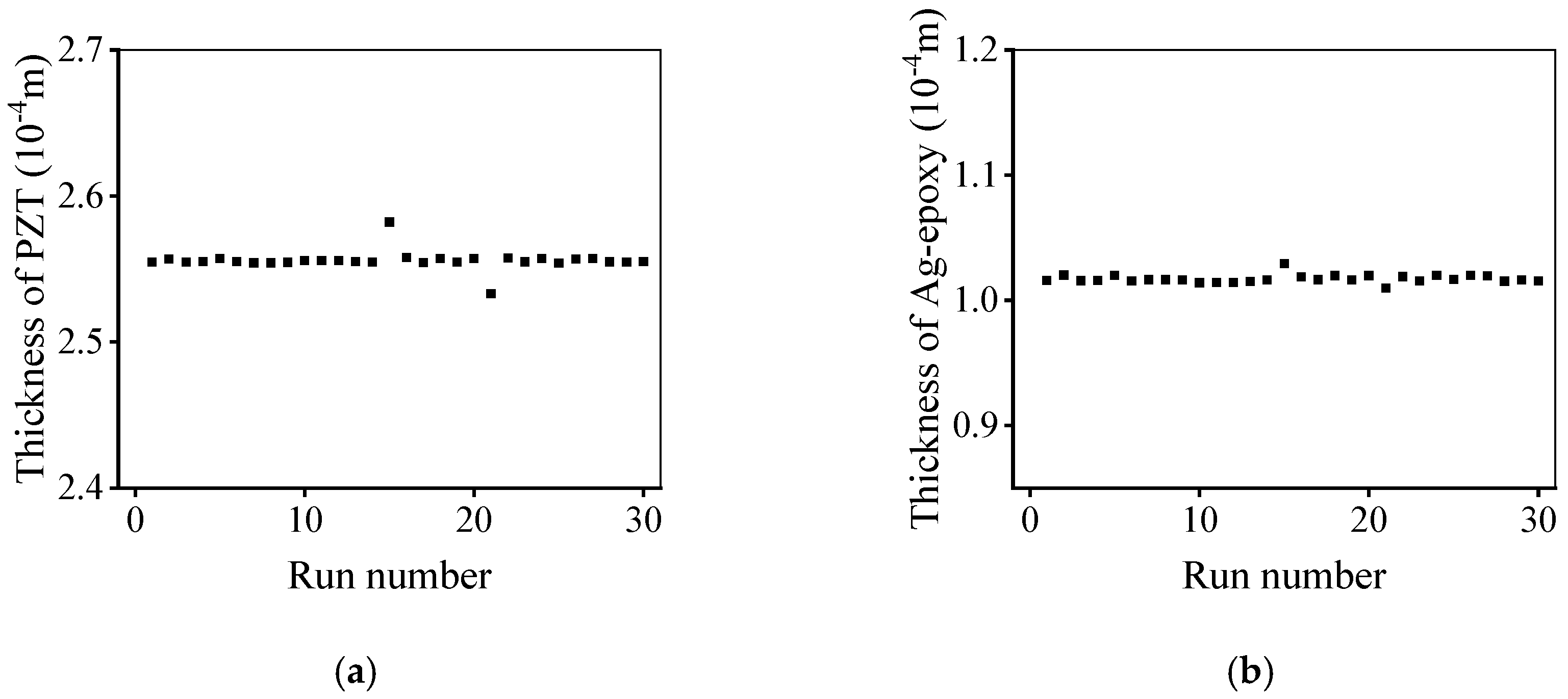
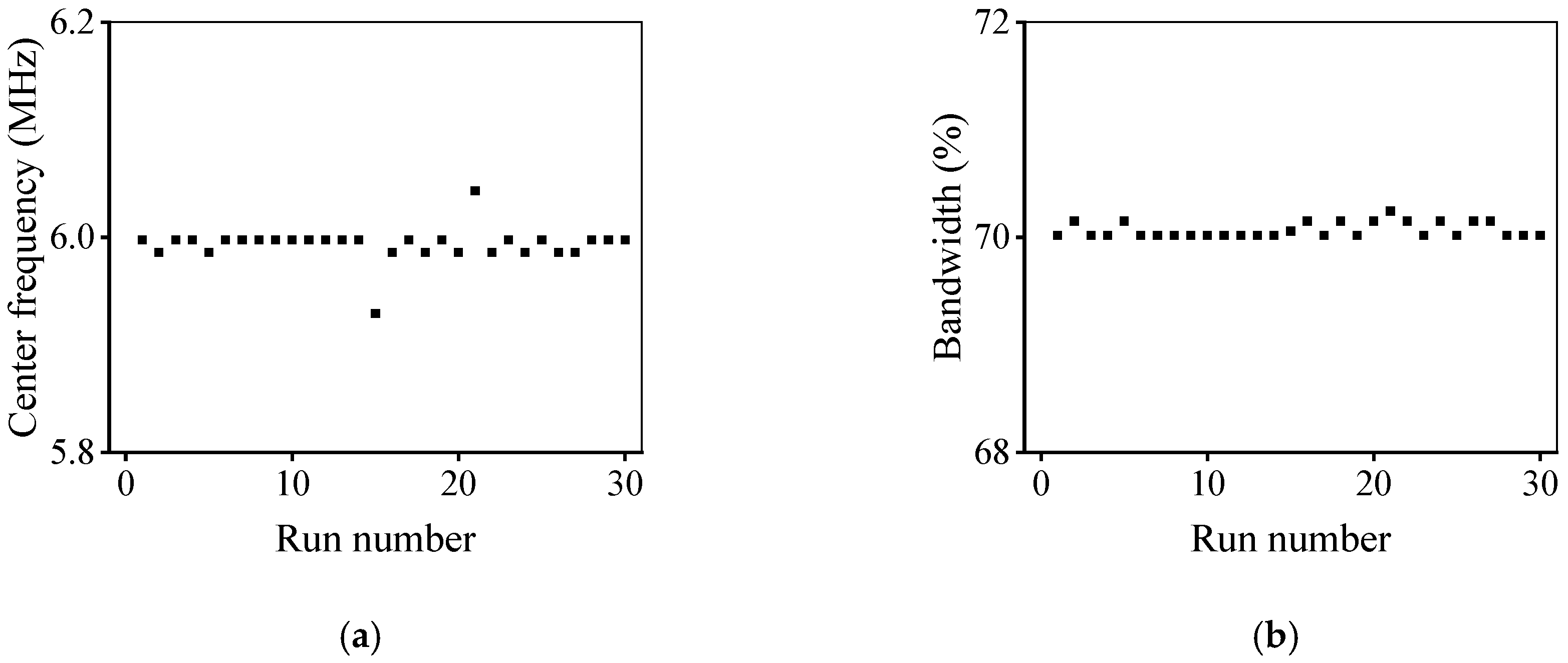
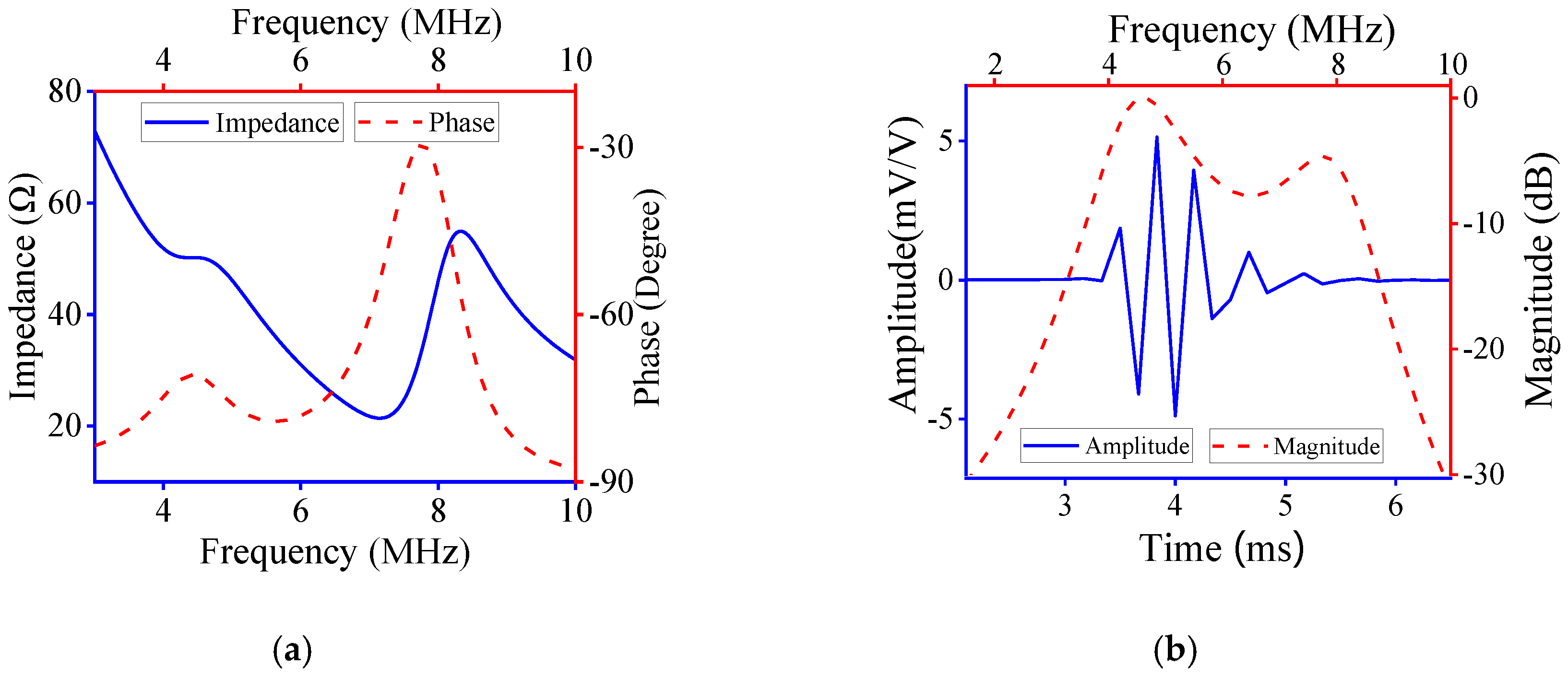
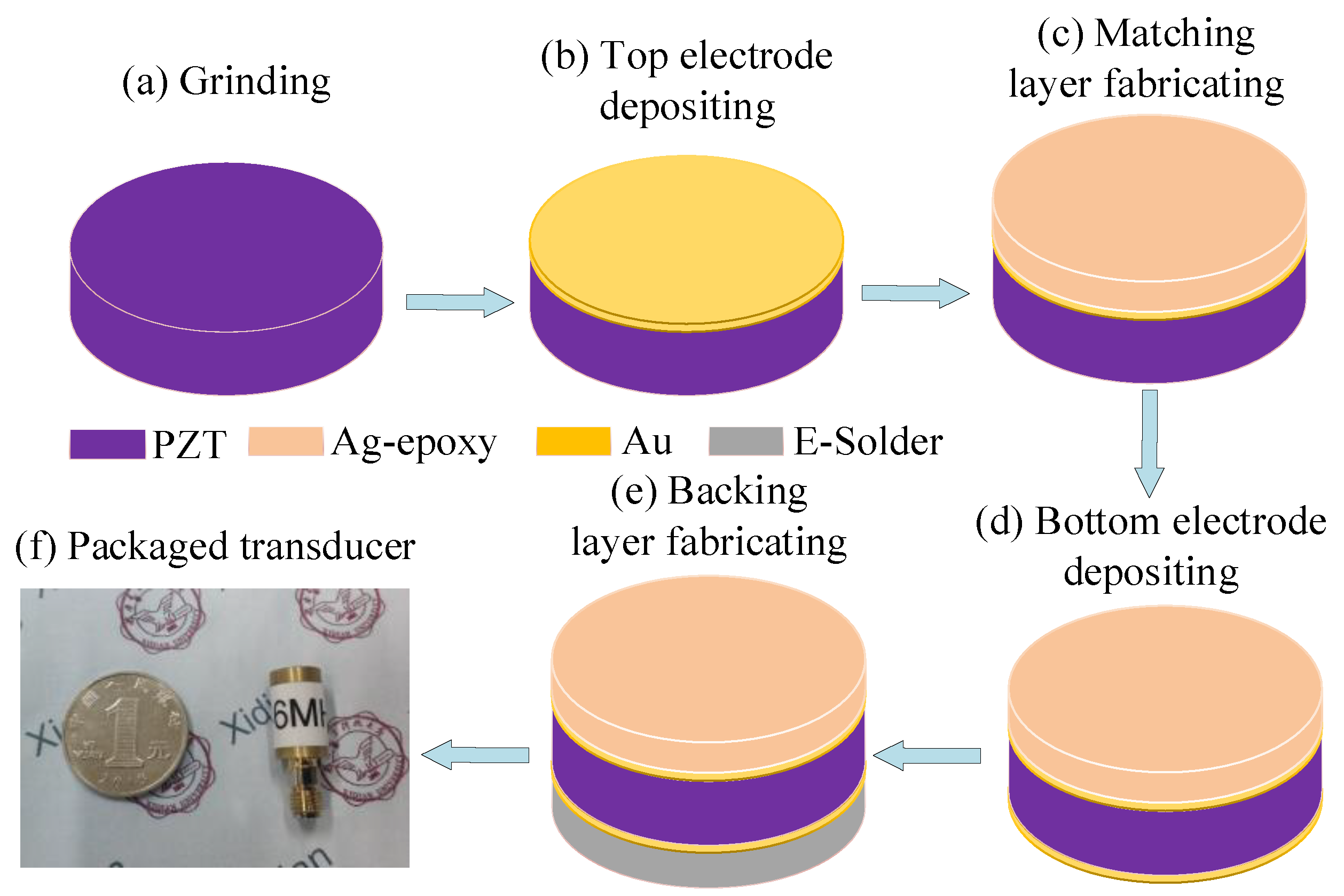
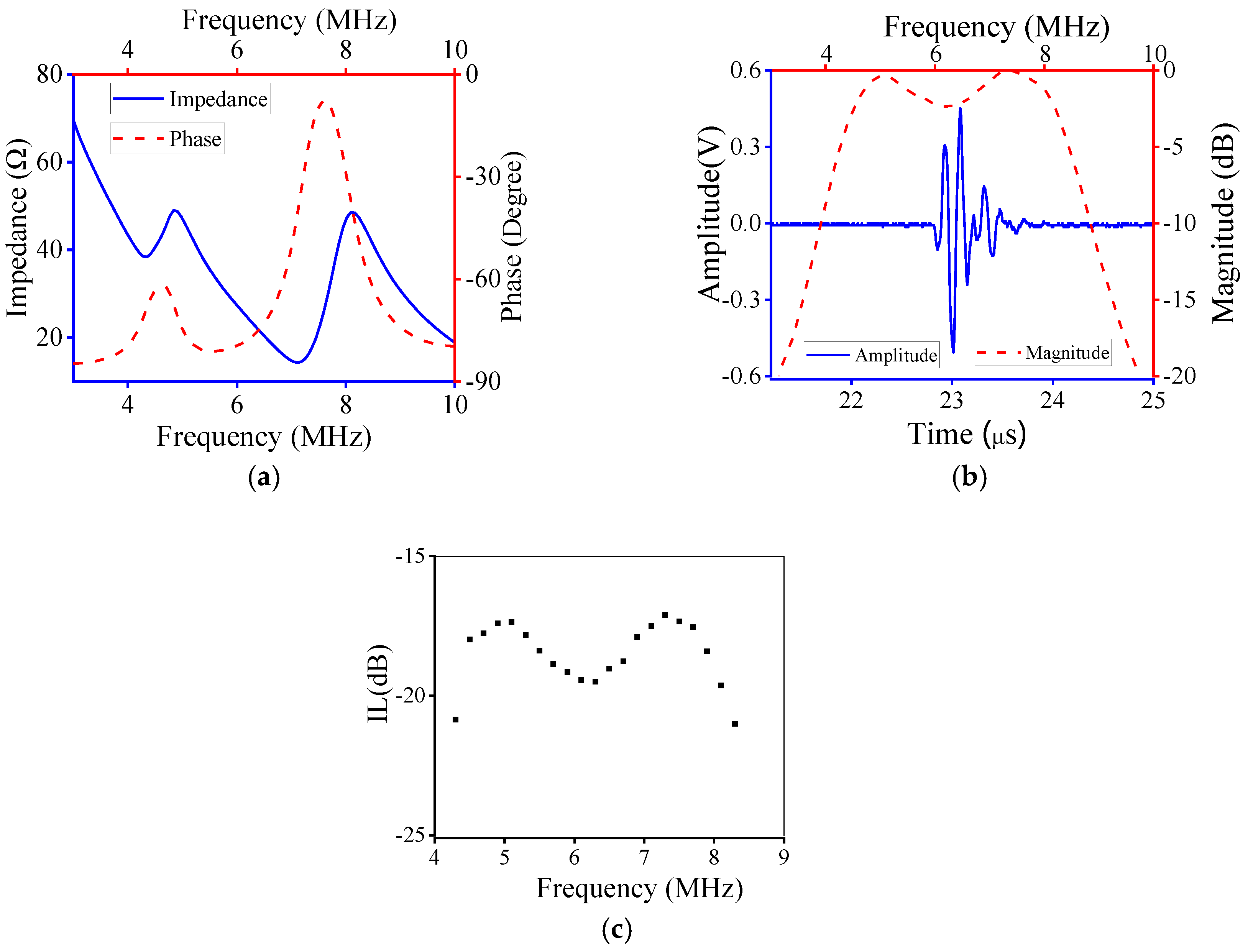
| Materials | Function | Velocity (m/s) | Density (kg/m3) | Acoustic Impedance (MRayl) | Dielectric Constant |
|---|---|---|---|---|---|
| PZT (PIC255) | Piezoelectric layer | 4044 | 7860 | 31.79 | 748 |
| Gold | Electrode | 3240 | 19,700 | 63.8 | - |
| Water | Front load | 1540 | 1000 | 1.54 | - |
| E-Solder | Backing layer | 1850 | 3200 | 5.92 | - |
| Ag-epoxy | Matching layer | 1900 | 3100 | 5.89 | - |
| Parameters of Optimality Criteria | Desired CF | |
| Desired BW | ||
| Weight Coefficients | , | |
| Parameters of PSO-LDIW algorithm | Constant parameters | , |
| Range of inertia weight | ||
| Maximum generation | ||
| Population size | ||
| Range of particle position | , | |
| Range of particle velocity | , |
| Performance | Pulse-Echo | |||
|---|---|---|---|---|
| f1(MHz) | f2(MHz) | CF(MHz) | BW(%) | |
| Design | / | / | 6 | 70.00 |
| Model | 3.89 | 8.11 | 5.99 | 70.40 |
| Experiment | 4.15 | 8.45 | 6.30 | 68.25 |
© 2020 by the authors. Licensee MDPI, Basel, Switzerland. This article is an open access article distributed under the terms and conditions of the Creative Commons Attribution (CC BY) license (http://creativecommons.org/licenses/by/4.0/).
Share and Cite
Chen, D.; Zhao, J.; Fei, C.; Li, D.; Zhu, Y.; Li, Z.; Guo, R.; Lou, L.; Feng, W.; Yang, Y. Particle Swarm Optimization Algorithm-Based Design Method for Ultrasonic Transducers. Micromachines 2020, 11, 715. https://doi.org/10.3390/mi11080715
Chen D, Zhao J, Fei C, Li D, Zhu Y, Li Z, Guo R, Lou L, Feng W, Yang Y. Particle Swarm Optimization Algorithm-Based Design Method for Ultrasonic Transducers. Micromachines. 2020; 11(8):715. https://doi.org/10.3390/mi11080715
Chicago/Turabian StyleChen, Dongdong, Jianxin Zhao, Chunlong Fei, Di Li, Yuanbo Zhu, Zhaoxi Li, Rong Guo, Lifei Lou, Wei Feng, and Yintang Yang. 2020. "Particle Swarm Optimization Algorithm-Based Design Method for Ultrasonic Transducers" Micromachines 11, no. 8: 715. https://doi.org/10.3390/mi11080715
APA StyleChen, D., Zhao, J., Fei, C., Li, D., Zhu, Y., Li, Z., Guo, R., Lou, L., Feng, W., & Yang, Y. (2020). Particle Swarm Optimization Algorithm-Based Design Method for Ultrasonic Transducers. Micromachines, 11(8), 715. https://doi.org/10.3390/mi11080715










